Well before I even dreamed that it was possible, let alone desirable, to spend so much time and money on surfskis, the Essex River Race gave me my first taste of competitive paddling. That bitter flavor lingered on my palette for the hour and seven minutes it took me to complete the race. I had thought I was a fast paddler, but it became a little hard to reconcile that belief given the empirical evidence of being passed every few minutes. It took me a a couple of years of getting beat down (OK, maybe seven) to wise up and start paddling a ski and then a couple more to get wise up further and start training with gusto (or, more often, reluctant tepidity).
The Essex River is practically my back yard (which explains the low-tide stench that occasionally wafts through the house, often right after taco night), so I planned to make the most of my home estuary advantage. We’d have a modest outgoing tide and light breeze ferrying us along for the first half of the race, but the tide would turn (not literally) on the way back home. I would dance nimbly from the channels to the shallows via a route that cross-optimized speed versus distance traveled.
The day got off to a rocky start as all six of the prime parking spots right across Route 22 from the boat launch were already taken, despite our pre-dawn arrival. I’m pretty sure Bob Capellini had been sleeping there in his truck since Thursday. I tried to put this setback behind me and prepare for the race ahead. Several long hours later, we were on the water awaiting our turn as the last heat of the day. As we floated idly about, Borys and Beata were conspicuously absent. I thought they might be granting us a head start, but it turns out they were just putting some final touches on their victory speeches.
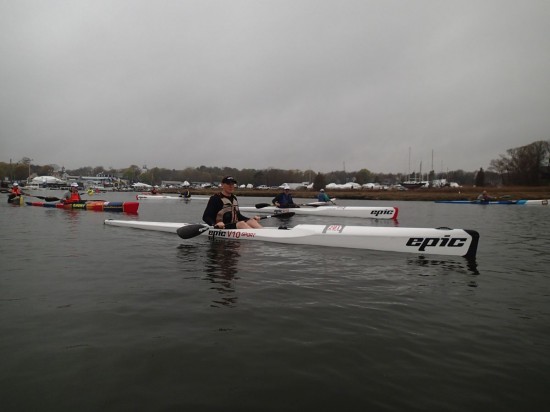
As I twist sideways to take this photo, Matt Drayer, Chris Sherwood, and Chris Chappell wait hungrily for me to either flip or drop my camera in the drink. No such luck, fellas.
I managed to get a good position near the left bank of the river, such that when the starting cannon fired from the right, I was barely grazed. I also was set up well for the initial left turn. Without having to burst any major organs, I was pulled along with the lead set of eight or so racers. So this is what it feels like to not be disheartened in the first minute of a race. It’s all right as a lark, but probably not for me. Makes for boring copy.
After a few moments, I started pulling my way forward, trying to do so with a little more grace than my oafish flailings at the Run of the Charles race. I eased by Chris Chappell and Bruce Deltorchio (who used this race to announce his engagement to a new V10 Sport, even though he’s still paying alimony to a string of ex-es), squeezed between Wesley and Francisco, and set my mark on Chris Laughlin and Andrius Zinkevichus up ahead. About five minutes into the race, I pulled ahead of these two and set my sights on Borys. That is, I was looking forward and he was probably one of those specks within my field of view.
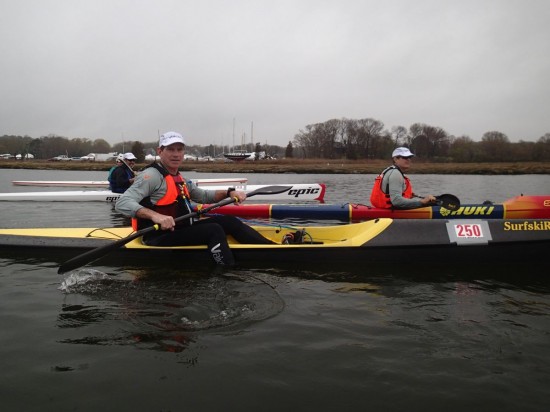
Before the race, I had to explain to an embarrassed Wesley that he had been misinterpreting “leg drive” all these years.
In the past, I’ve always been guided through the winding portion of the race by a pack of faster seeing-eye paddlers. Even if I had different ideas about the best route, it never seemed worth giving up the advantages of the draft. This year, after the first half mile I found myself with Open Waters well out ahead of me (I’m suggesting that as Borys’ new nickname) and Andrius drafting off to my starboard. Perfect. I could use my knowledge of the river to plot an optimal course.
What I hadn’t considered, however, is that my preferred route would frequently intersect with the seemingly random courses of the first wave of rowing craft, heading back towards the finish. In other mixed-craft races like the Snow Row or Blackburn Challenge, working your way around the wide oarspans of rowboats can be challenging. In those races, however, you’re generally overtaking a boat at a relative speed of a knot or two, the rowers can see you coming, and you have an ocean to maneuver in. In the Essex, you’re approaching each other at a combined speed of 12+ knots, the rowers are blind to your presence, and you’re in a winding river. Also, because they can’t see where they’re going, they tend to pursue a course down the middle of the channel while always seeming to be about 8 degrees askew from heading straight downriver.
The stage has been set for bad navigation decisions, and I was just the person to make them. In trying to stay in the channel to reap the benefits of the tidal current, I found I was erring on the side of “holy geez, that was close” as I misjudged the course and oarspan of the oncoming blurs. A six man behemoth roared by inches off my port side. Fortunately my heart got stuck in my throat, or it would have been whisked right along downstream with the rowboat. I left ample room for the next several rowboats to pass on my the port side (you might reasonably assume that I had learned my lesson from the close call, but don’t jump the gun…), after which I was confronted with a disaster-in-waiting. Ahead, a two person shell and a six person rowboat were bearing down on me. They appeared at first to be abreast of one another, but it turned out that the shell was actually a length or two in front.
I could either yield the direct route and go to the right of both boats or stay true to the channel current and split their difference. In my split-second appraisal (a wildly inaccurate use of that term) of the situation, I judged there to be enough of a gap for the latter course. I angled to port to clear the shell, then straightened out to keep from straying further left into the path of the workboat. I shot through the gap with several feet to spare on either side. Whew. Except…
A pained grunt from my right attested that I had neglected one critical element in planning my trajectory. The astute reader may recall that I wasn’t alone at this point, but was pulling Andrius on a starboard draft. I hadn’t pulled far enough left, leaving insufficient room between my boat and the two person shell. Andrius took an oar to the chest but managed to stay upright and in contact. For the next few moments, that contact consisted mostly of us debating (in what might be described as “flowery terms”) the finer points of sportsmanship.
In retrospect, I have to concede that if I were Andrius, I’d have been plenty unhappy too. It was a stupid decision to pass between the two craft in the first place, but once I had committed to that course I should have ensured that we both had ample room. All I can offer in my defense is that it was a reckless and poorly executed move (for which I have apologized) rather than a malicious tactic.
Now that I’ve brought the race report to a screeching halt with this mea culpa, let’s see if I can lighten things up by returning once more to a deep and generous well – having some good-natured fun at the expense of our friend Bill Kuklinski. Ostensibly because Bill would be entertaining us immediately after the race, the organizers asked that he start in one of the early heats. This was just as well, since the squirrel bladders in his Victorian-era life vest tend to lose buoyancy as the temperature rises. Bill has paddled the Essex course many times (occasionally multiple times during the same race, if I’m not mistaken) and knows the perils of Devastation Reef as well as anyone. Since you could literally hop to shore on Cross Island from this hazard, I’m not sure that it technically qualifies as a reef, but nevertheless many a craft has been dashed (or, at least, gently grounded) on its jagged maw. Alas, that list now includes Bill’s Epic. Fortunately, as master glasser Chris Chappell diagnosed after inspecting the damage, it’s nothing that a little Wite-Out and baling wire can’t fix. Although he did look a little dehydrated after the race, Bill seems to have weathered his shipwreck with only financial scars.
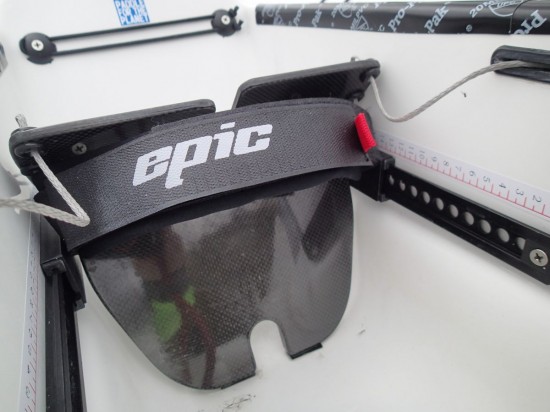
For the second race in a row, my GoPro failed me. What gives? It’s got like two buttons. I did get a pretty good still shot of my foot plate, though.
Back in real time, I managed to tear free from Andrius a quarter mile or so later. Borys, of course, had pulled his typical disappearing act, so I was on my own. Fortunately, the Essex race includes a string of mobile motivational waypoints (MMWs) in the form of kayaks in slower classes from earlier starting heats. Overtaking one of these obliging targets every couple of minutes helps to keep the spirits up in the struggle against fatigue. Of course, the MMWs are by definition in boats that are inherently much slower than mine, but (a) I find it pretty easy to selectively ignore that fact and (b) it’s not my fault if you race in a 12 foot rotomolded kayak.
Remembering my time as a hapless waypoint for the skis, I made sure that I paid it forward. Approaching each new boat, I did everything I could to put on a good show. That is, I temporarily stopped moaning and gasping for air, straightened up my fatigue-induced slouch, did my best imitation of a graceful stroke, and tossed off a carefree “Cheerio!” as I passed. With any luck, my charade would allow them to share in that same desperate inadequacy I felt back in 2004. I do have the concept of paying it forward right, yeah?
Somebody at headquarters miscalibrated a couple of the MMWs. Although I had spotted Dana Gaines and Bob Capellini (the leaders of the SS20+ class) with a couple of miles left in the race, I didn’t actually seem to be closing on them. The entire point of the MMW program is to provide an invigorating burst of confidence as you cruise by these paddlers (again, overlooking that they are in much slower boats). Dana and Bob were pushing their burly skis way too fast, which I found more frustrating than motivating. Come on, guys. Get with the program. Finally, with less than a half mile to go, I managed to pass Dana and then Bob. I finished with an anemic sprint that left one smart-ass spectator wondering aloud if I was also in the race.
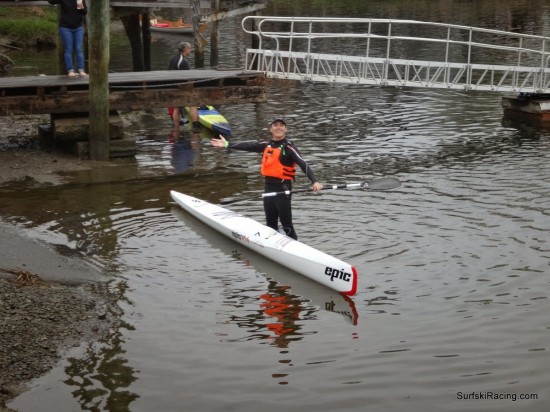
Tim’s unexpected rendition of “Oh, What a Beautiful Morning!” was a little off key, but still oddly moving. (Photo courtesy of Wesley Echols)
Despite having my own personal best time on the Essex course by 1.5 minutes, Borys had finished nearly 4 minutes in front of me, breaking his 2012 paddling record with a time of 42:17. While Borys and I had spent most of the race in isolation, most of the other paddlers were engaged in pitched combat within various pods, complete with parries, feints, and, at least in my envious imagination, witty repartee. After battling for much of the last two-thirds of the race, Andrius edged out Chris (Laughlin) for 3rd. Wesley bested hard-charging Mike for 5th, with Beata and Bruce Deltorchio hard on their sterns. Chris Chappell managed to hold off a late surge by Tim Dwyer, who slipped by Kirk Olsen and Tim Hudyncia in his push to fill out the top 10.
With little wind and mild tidal currents, it was a fast day on the Essex. Most paddlers who stayed in comparable boats beat their 2013 times by 1 to 2 minutes. A few cheaters upboated from the SS20+ class to improve their times by 5 minutes or more. Tim Hudyncia and Mary Beth, however, turned in the most improved times, each shaving nearly 9 minutes off of last year’s times without radically changing boats. Mary Beth is so attached to her (fine, you all win) new boat that she has started bringing it to bed, which has made spooning a little awkward.
Last report’s call-to-arms for New England paddlers was answered in no uncertain terms. In this race, eight of the top ten spots went to native paddlers. Granted, the metropaddlers were pretty thinly represented this time, with regulars Jan Lupinski and Eric Costanzo apparently too frightened and/or busy with other commitments to make the trip to Essex. Still, this race proves conclusively that in the absence of competition, we will fill in the open places in the results.
For those of us in the North Shore of Massachusetts, our next race is the opening salvo in the summer-long barrage of pain called the Salem League. For everyone else, the Sakonnet calls in early June. In any event, we’re abandoning calm river waters and casting off into rougher seas. And yes, I have started practicing my remounts. Thanks for asking.
(Reprinted from Full Tilt)
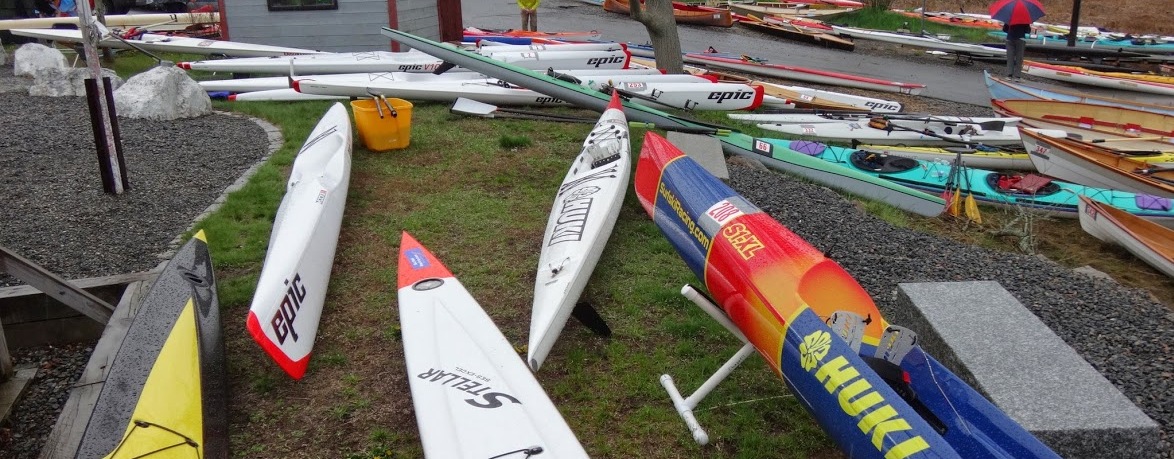
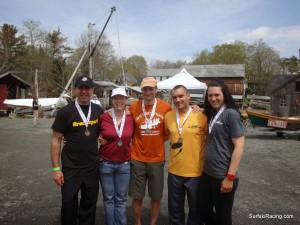
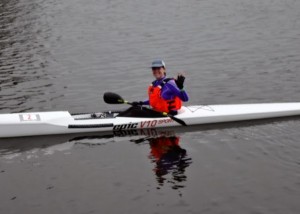
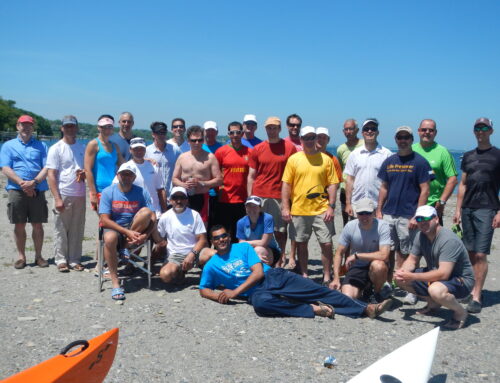
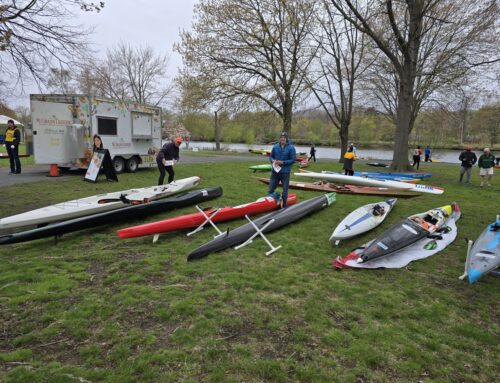
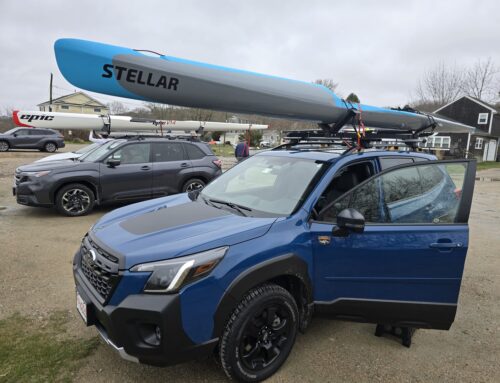
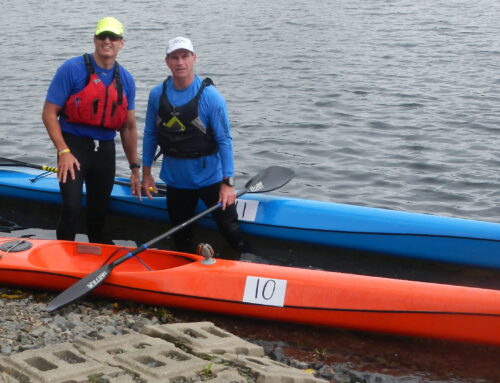
Leave A Comment
You must be logged in to post a comment.